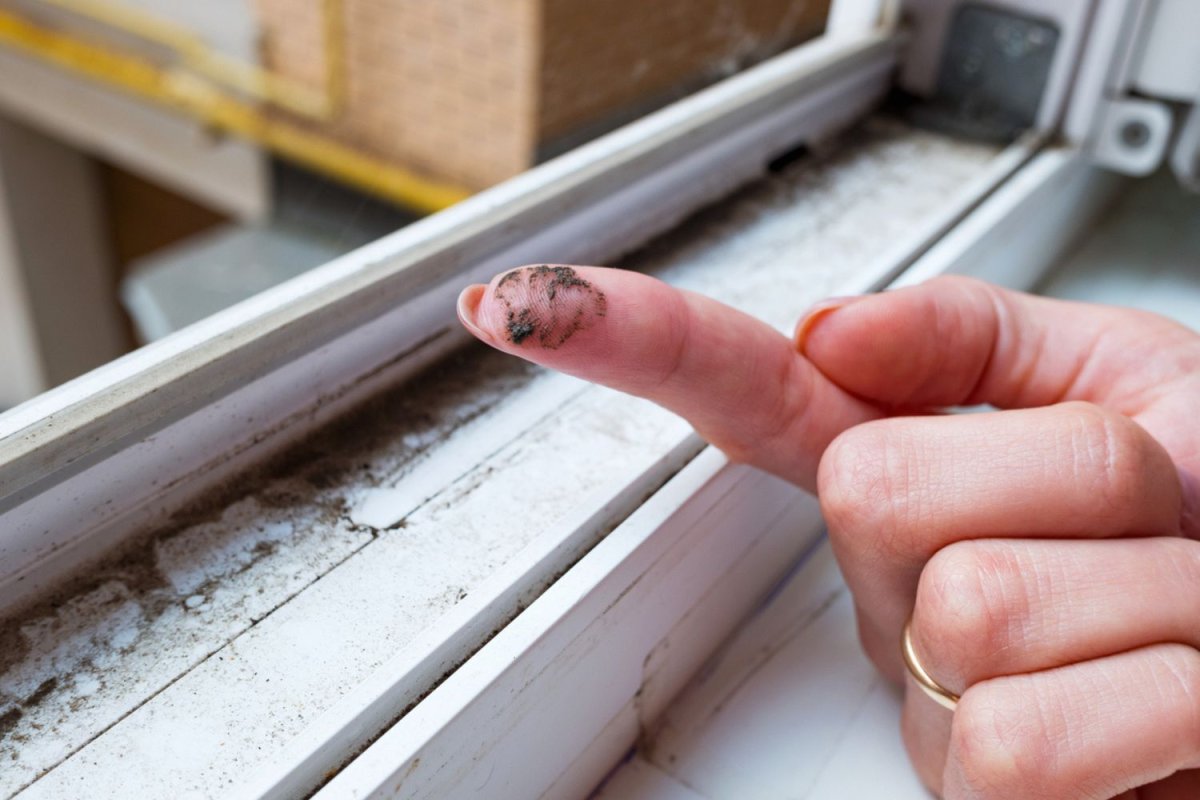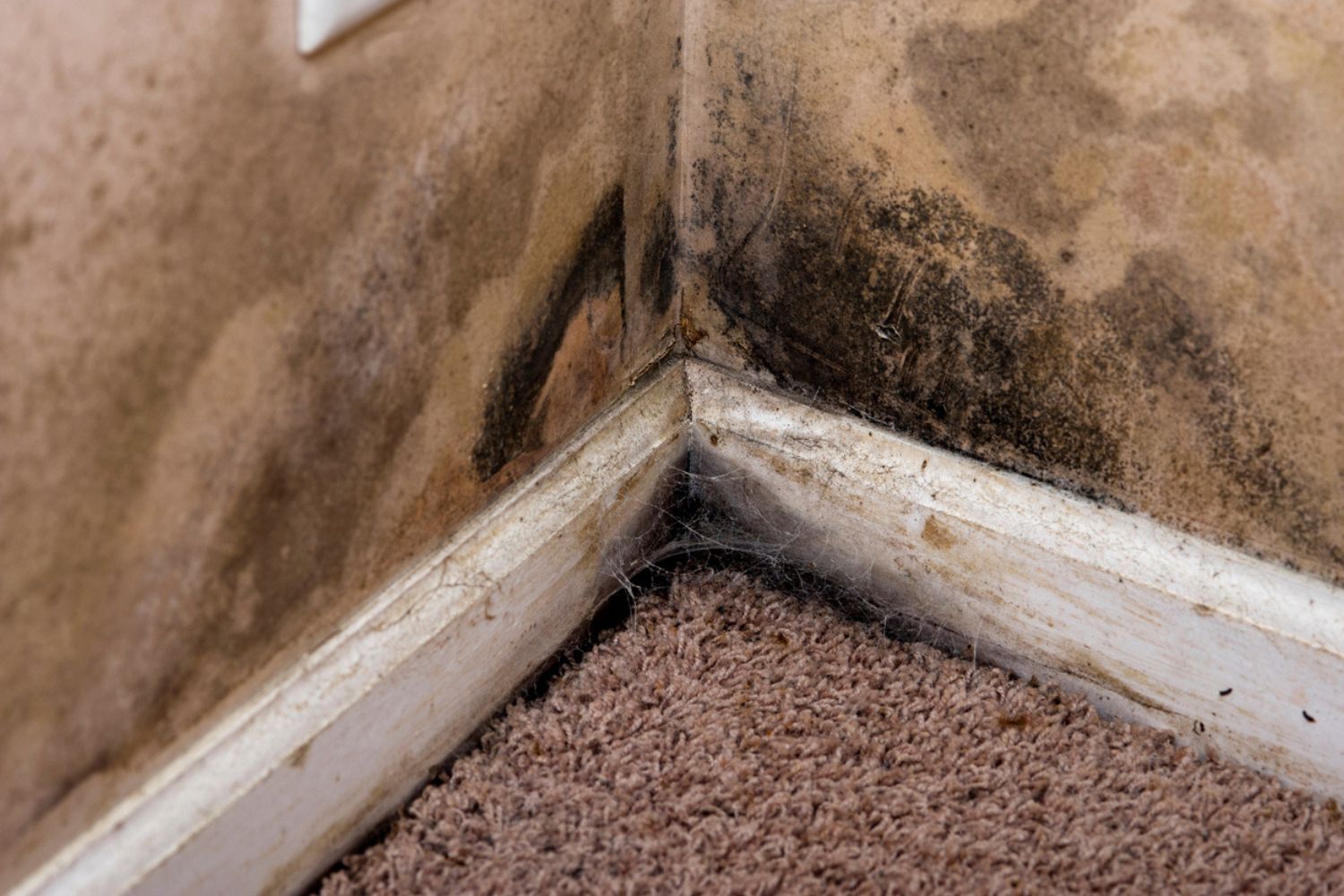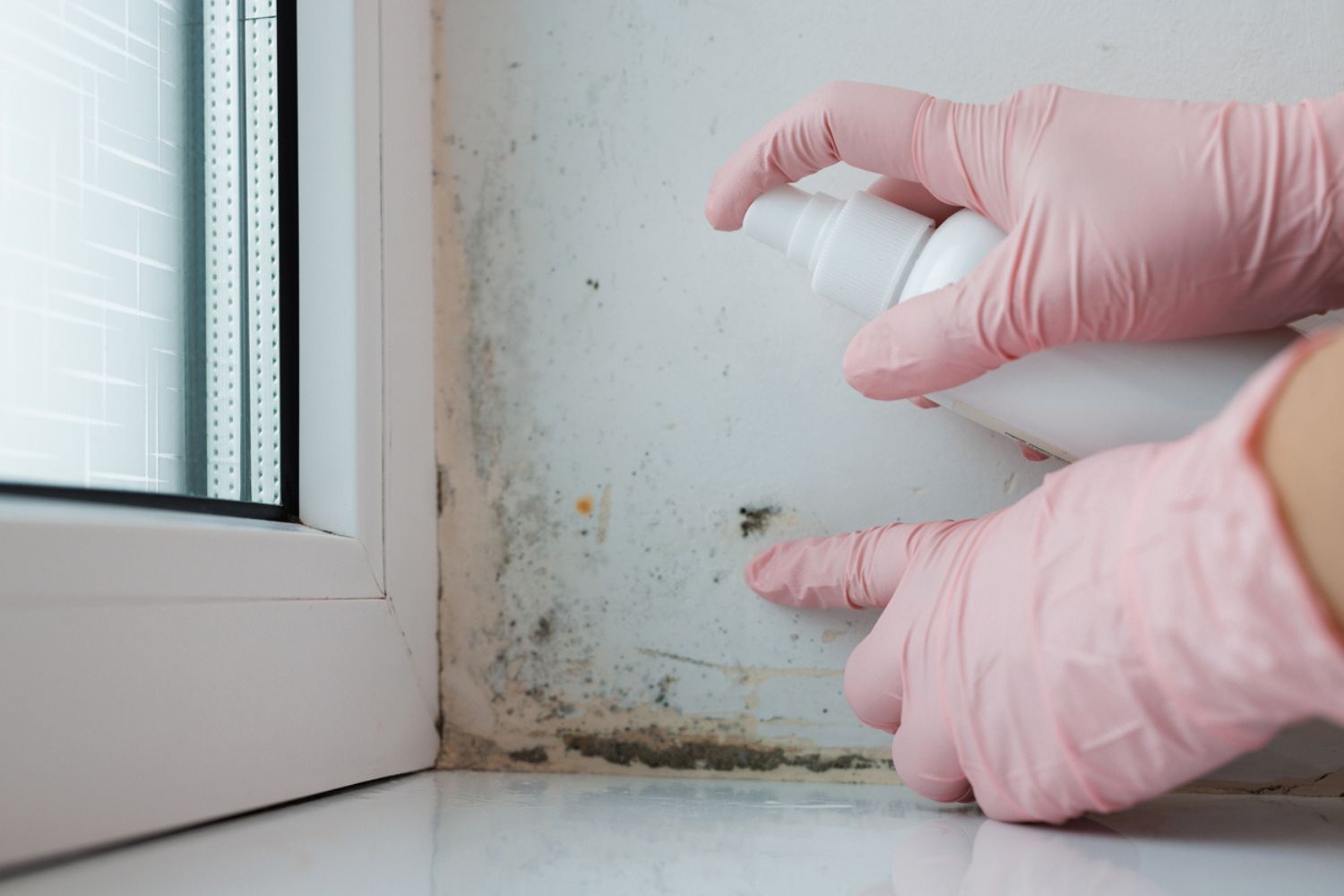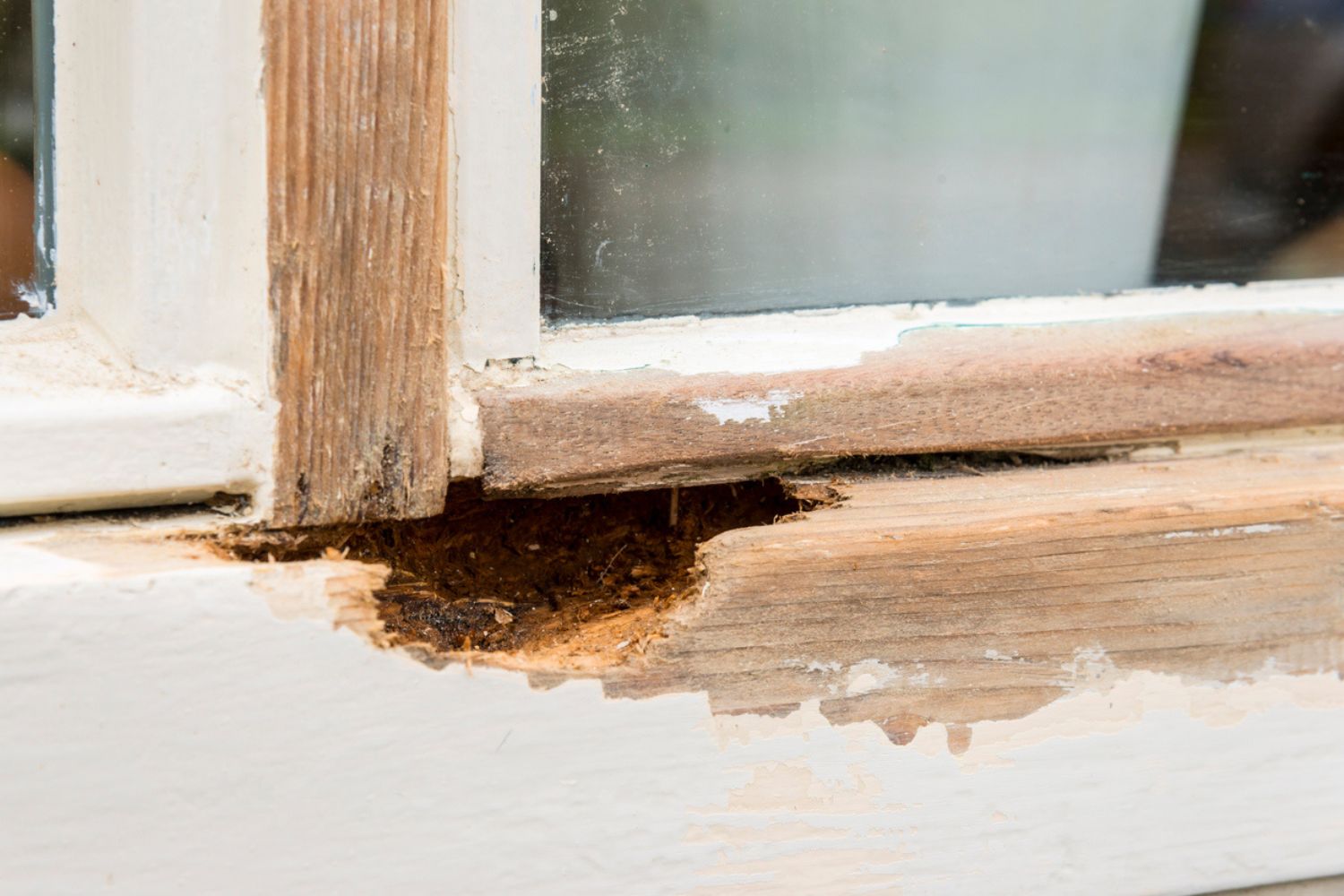

We may earn revenue from the products available on this page and participate in affiliate programs. Learn More ›
The differences between black mold and wood rot may seem minimal at first glance. Both occur on wood surfaces as a result of exposure to excess moisture, and both can spread if not treated quickly. However, the dangers presented by each of these issues are different. Black mold is a fungus that can lead to health concerns, especially for people with respiratory issues, whereas advanced wood rot has the potential to cause structural problems in a home. Wood rot is decay that leads to the breakdown of the cellulose in wood, and it can cause musty smells; splitting; cracking; crumbling; and a soft, spongy texture. Although wood rot is more likely to occur in wood outside, it can also be found in crawl spaces or basements that are subject to more humidity or moisture from leaks. Black mold can also be found in areas with high humidity, such as bathrooms, kitchens, or basements. For those who are struggling to figure out which issue they are dealing with, identifying more specific characteristics can be useful in determining what steps to take next.
Main Causes of Black Mold and Wood Rot Spread
Wood rot and black mold can have similar warning signs. This overlap can complicate identification, but understanding the causes of each may make it easier to determine the source of wood rot or black mold.
Causes of wood rot:
- Excess moisture from leaks, high humidity, or improper drainage
- Poor air circulation
- Untreated or unprotected wood
- Direct contact with soil
- Wood type is more susceptible to rot
- Aging wood that’s more porous and prone to decay
Causes of black mold:
- Excess moisture from leaks, high humidity, or flooding
- Water damage from leaks in roofs, walls, or plumbing
- Condensation
- Poor air circulation
- Lack of or improper cleaning
While the causes of black mold and wood rot are often related, each of these problems will manifest differently in a home. Being able to identify the unique symptoms of black mold vs. wood rot will help with differentiating between them.

1. Black mold and wood rot both emit a musty smell, so it may take additional investigation to identify the root problem.
Although it’s one of the most noticeable signs, a musty or mildewy smell is not a deciding factor in whether wood rot or black mold is present. Anyone who has looked up what mold smells like is likely to have found that a “musty” scent is common. But because that signature smell is caused by damp conditions, it can be a sign of both wood rot and black mold. It can be tempting to get rid of odors in the house by trying to cover them up. However, if there is a musty scent emanating from the basement, crawl space, or other area inside the home, it’s crucial to address it and not leave the source untreated. Whatever is causing the smell, it’s likely to spread or result in additional damage. If the source of the smell cannot be located, consider having either a foundation repair professional or a mold remediation professional perform an inspection.
2. Bouncy floorboards are a telltale sign of deterioration from wood rot, whereas black mold will likely not affect the integrity of the wood.
Since exposure to moisture causes the structure of wood to break down, deterioration from wood rot can cause soft, bouncy spots in a home’s floorboards. Infected wood can give what was once a solid surface a mushy feel, which is why some areas may be bouncier than others.
By contrast, mold forms on the surface of wood but will not typically cause it to deteriorate, meaning it is not likely to lead to structural damage. Bouncy floorboards aren’t the only sign of wood rot in a home, however. Other signs include discoloration in the affected area, cracks and splits, crumbling wood, or excess moisture from a leak or nearby water source. All of these signs are an indication that it may be time to consult the best flooring company near you to see if it’s possible to replace the rotten boards or identify the cause of the wood damage.

3. Wood rot won’t cause health issues in people, but black mold can cause symptoms such as congestion or itchy eyes.
A good way to tell the difference between black mold and wood rot is to pay attention to any physical symptoms that a home’s residents may be experiencing. Coming into contact with dry rot fungi isn’t likely to lead to any health effects. However, when mold spores spread throughout a home, they can cause unpleasant health issues in humans. Exposure to black mold can cause the following symptoms, especially in people with pre-existing medical conditions and respiratory issues:
- irritation in the eyes
- coughing
- runny nose
- scratchy or irritated throat
- sneezing
- wheezing
- skin rash
- hay fever-type symptoms
According to the Environmental Protection Agency (EPA), people with asthma or those who suffer from allergies can experience asthma attacks or allergic reactions when they come into contact with mold. For this reason, it’s important to have a professional identify black mold. It’s also worth noting that black mold is a toxigenic mold, which means that it produces mycotoxins that can be hazardous to humans. However, it is not the only type of mold that can be detrimental to health. Allergenic molds are a variety that can trigger symptoms in people who are sensitive to these molds. Pathogenic molds are known to cause infections, which is especially dangerous for those who have weakened immune systems. Consider having a mold remediation professional test for mold if any family members are having symptoms of mold exposure.

4. Rotten wood will look shrunken or decayed, whereas wood affected by mold will appear slimy or fuzzy.
From an appearance standpoint, wood rot is relatively easy to identify. The wood itself is usually misshapen or deformed, with visible splinters or cracks that show its decay. By contrast, wood affected by mold may simply appear to be discolored until the growth is advanced. Mold that has latched on to dry wood can cause boards to take on a yellow or brownish hue, especially in areas close to the black mold. Because mold can produce sticky spores, black mold looks like a slimy or fuzzy residue on the wood. When dry, it may take on a powdery consistency. While it will often appear in a circular pattern, black mold can also form patches with irregular shapes.
5. Both of these problems require urgent attention as wood rot can do significant structural damage and black mold is a serious health hazard.
Regardless of whether wood rot or black mold is impacting the home, the effects of either are dangerous and can lead to more problems down the road if they’re not dealt with as soon as possible. Wood rot can make a home a structural liability as floor joists have the potential to give way once they are rotted through. The longer wood rot goes unaddressed, the more costly repairs will become as the problem progresses. While mold can eventually cause wood to deteriorate, this happens at a much slower rate than wood rot. However, black mold can spread and lead to health issues, especially for those with existing respiratory conditions. For this reason, simply painting over mold will not be a sufficient solution. In its earliest stages, mold can be removed from the surface of wood using vinegar or bleach. However, the EPA recommends that remediation of mold growth of over 10 square feet will need to be carried out by a mold remediation specialist, and those with underlying health concerns will want to avoid contact with mold completely. For reference, mold remediation costs $2,254 on average.

6. A mold remediation company can treat black mold growth throughout the home. For mold or wood rot in a crawl space, consider calling a foundation repair company.
The best mold removal companies have the equipment and experience to turn a musty, mold-infected space into the haven it once was. In many cases, mold removal professionals will bring in big fans or dehumidifiers to treat the home once the mold is identified and removed. They can also apply preventive treatment to the home so that mold will not develop again. If it is determined that there is a case of wood rot in the crawl space, this kind of problem is best addressed by a foundation repair company. Any stale, earthy smell in a basement or crawl space is a good indicator that there is an issue at play, and wood rot can lead to serious structural issues that one of the best foundation repair companies will be able to identify and address.
7. Prevention is key: Controlling humidity levels with basement waterproofing or crawl space encapsulation can prevent future wood rot and black mold growth.
Although the cost of crawl space encapsulation may seem exorbitant up front, it’s worth it if it can prevent damage from wood rot or black mold growth. Homeowners typically pay between $1,500 and $15,000 for this service. For those who live in a region with high levels of humidity, encapsulating the crawl space can protect the underside of the home’s flooring by blocking humidity and controlling how much moisture seeps in. The cost of basement waterproofing is similarly worth it. The best basement waterproofing companies will fill any existing cracks with cement and apply a masonry waterproofing product to any bare interior walls. Both prevention methods can ensure a home’s structure stays sound, regardless of any future leaks or exposure to moisture.
